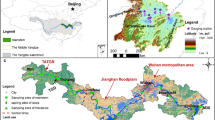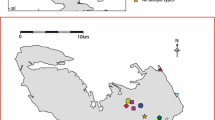Abstract
The evolution of dissolved organic carbon (DOC) molecular-weight fractions, DOC biodegradability (BDOC), DOC origin [fluorescence index (FI)], and enzyme activities between the stream waters (main and ephemeral channel) and ground waters (riparian and hillslope) were analyzed during the transition from drought to precipitation in a forested Mediterranean stream. After the first rains, DOC content in stream water reached its maximum value (10–18 mg L−1), being explained by the leaching of deciduous leaves accumulated on the stream bed during drought. During this period, the largest molecules (>10 kDa), were the most biodegradable, as indicated by high BDOC values measured during storm events and high enzymatic activities (especially for leucine-aminopeptidase). DOC >100 kDa was strongly immobilized (78%) at the stream–riparian interface, whereas the smallest molecules (<1 kDa) were highly mobile and accumulated in ground waters, indicating their greater recalcitrance. Differential enzymatic patterns between compartments showed a fast utilization of polysaccharides in the flowing water but a major protein utilization in the ground water. The results of the FI indicated a more terrestrial origin of the larger molecules in the flowing water, also suggesting that transformation of material occurs through the stream–riparian interface. Microbial immobilization and fast utilization of the most biodegradable fraction at the stream–riparian interface is suggested as a relevant DOC retention mechanism just after initial recharging of the ground water compartment. Large and rapid DOC inputs entering the intermittent river system during the transition from drought to precipitation provide available N and C sources for the heterotrophs. Heterotrophs efficiently utilize these resources that were in limited supply during the period of drought. Such changes in C cycling may highlight possible changes in organic matter dynamics under the prediction of extended drying periods in aquatic ecosystems.








Similar content being viewed by others
References
Acuña, V, Muñoz, I, Giorgi, A, Omella, M, Sabater, F, Sabater, S (2005) Drought and post-drought recovery cycles in an intermittent Mediterranean stream: structural and functional aspects. J N Am Benthol Soc 24: 919–933
Acuña, V, Giorgi, A, Muñoz, I, Uehlinger, U, Sabater, S (2004) Flow extremes and benthic organic matter shape the metabolism of a headwater Mediterranean stream. Freshw Biol 49: 960–971
Amon, RMW, Benner, R (1996) Bacterial utilization of different size classes of dissolved organic matter. Limnol Oceanogr 41: 41–51
Bernal, S, Butturini, A, Sabater, F (2002) Variability of DOC and nitrate responses to storms in a small Mediterranean forested catchment. Hydrol Earth Syst Sci 6: 1031–1041
Bernal, S, Butturini, A, Sabater, F (2005) Seasonal variations of dissolved nitrogen and DOC:DON ratios in an intermittent Mediterranean stream. Biogeochemistry 75: 351–372
Bonin, HL, Griffiths, RP, Caldwell, BA (2000) Nutrient and microbiological characteristics of fine benthic organic matter in mountain streams. J N Am Benthol Soc 19: 235–249
Burns, A, Ryder, DS (2001) Response of bacterial extracellular enzymes to inundation of floodplain sediments. Freshw Biol 46: 1299–1307
Butturini, A, Bernal, S, Nin, E, Hellin, C, Rivero, L, Sabater, S, Sabater, F (2003) Influences of the stream groundwater hydrology on nitrate concentration in unsaturated riparian area bounded by an intermittent Mediterranean stream. Water Resour Res 39: 1110, doi:10.1029/2001WR001260
Butturini, A, Bernal, S, Sabater, F (2005) Modeling storm events to investigate the influence of the stream–catchment interface zone on stream biogeochemistry. Water Resour Res 41: 8418
Chróst, RJ (1991) Environmental control of the synthesis and activity of aquatic microbial ectoenzymes. In: Chrost, RJ (Ed.) Microbial Enzymes in Aquatic Environments. Brock/Springer Verlag, New York, pp 29–59
Dahm, CN, Grimm, NB, Marmonier, P, Valett, HM, Vervier, P (1998) Nutrient dynamics at the interface between surface waters and groundwaters. Freshw Biol 40: 427–451
Dahm, CN, Baker, MA, Moore, DI, Thibault, JR (2003) Coupled biogeochemical and hydrological responses of streams and rivers to drought. Freshw Biol 48: 1219–1231
Fiebig, DM, Marxsen, J (1992) Immobilization and mineralization of dissolved free amino acids by stream-bed biofilms. Freshw Biol 28: 129–140
Findlay, S, Strayer, D, Goumbala, C, Gould, K (1993) Metabolism of stream water dissolved organic carbon in the shallow hyporheic zone. Limnol Oceanogr 38: 1493–1499
Findlay, SE, Sinsabaugh, RL, Sobczak, WV, Hoostal, M (2003) Metabolic response of hyporheic microbial communities to variations in supply of dissolved organic matter. Limnol Oceanogr 48: 1608–1617
Fischer, H, Sachse, A, Steinbeg, CEW, Pusch, M (2002) Differential retention of dissolved organic carbon by bacteria in river sediments. Limnol Oceanogr 47: 1702–1711
Gordon, ND, McMahon, TA, Finlayson, BL (1992) Stream Hydrology. An Introduction for Ecologists. Prentice-Hall, New Jersey, USA
Gucker, B, Boechat, IG (2004) Stream morphology controls ammonium retention in tropical headwaters. Ecology 10: 2818–2827
Gremm, TJ, Kaplan, LA (1998) Dissolved carbohydrate concentration, composition, and bioavailability to microbial heterotrophs in stream water. Acta Hydrochim Hydrobiol 26: 167–171
Harvey, HR, Mannino, A (2001) The chemical composition and cycling of particulate and macromolecular dissolved organic matter in temperate estuaries as revealed by molecular organic tracers. Org Geochem 32: 527–542
Hongve, D, VanHees, PAW, Lundström, US (2000) Dissolved components in precipitation water percolated through forest litter. Eur J Soil Sci 51: 667–677
Hooper, RP (2003) Diagnostic tools for mixing models of stream water chemistry. Water Resour Res 39: 1055, doi:10.1029/2002WR001528, 2003
Humphries, P, Baldwin, DS (2003) Drought and aquatic ecosystems: an introduction. Freshw Biol 48: 1141–1146
Kaiser, E, Sulzberger, B (2004) Phototransformation of riverine dissolved organic matter (DOM) in the presence of abundant iron: effect on DOM bioavailability. Limnol Ocenanogr 49: 540–554
Karrasch, B, Bormki, G, Herzsprung, P, Winkler, M, Baborowski, M (2003) Extracellular enzyme activity in the river Elbe during a spring flood event. Acta Hydrochim Hydrobiol 31: 307–318
Ladd, TI, Ventullo, RM, Wallis, PM, Costerton, JW (1982) Heterotrophic activity and biodegradation of labile and refractory compounds by groundwater and stream microbial populations. Appl Environ Microbiol 44: 321–329
Lake, PS (2003) Ecological effects of perturbation by drought in flowing waters. Freshwat Biol 48: 1161–1172
Marmonier, P, Fontvieille, D, Gibert, J, Vanek, V (1995) Distribution of dissolved organic carbon and bacteria at the interface between the Rhone River and its alluvial aquifer. J N Am Benthol Soc 14: 382–392
McArthur, MD, Richardson, JS (2002) Microbial utilization of dissolved organic carbon leached from riparian litterfall. Can J Fish Aquat Sci 59: 1668–1676
McKnight, DM, Boyer, EW, Westerhoff, PK, Doran, PT, Kulbe, T, Andersen, DT (2001) Spectrofluorometric characterization of dissolved organic matter for indication of precursor organic material and aromaticity. Limnol Oceanogr 46: 38–48
Meyer, JL, Edwards, RT, Risley, R (1987) Bacterial growth on dissolved organic carbon from a blackwater river. Microb Ecol 13: 13–29
Mulholland, PJ (2003) Large-scale patterns in dissolved organic carbon concentration, flux and sources. In: Findlay, SE, Sinsabaugh, RL (Eds.) Aquatic Ecosystems, Interactivity of Dissolved Organic Matter. Academic Press, Elsevier, San Diego, pp 139–159
Münster, U, DeHaan, H (1998) The role of microbial extracellular enzymes in the transformation of dissolved organic matter in humic waters. In: Hessen, DO, Tranvik, LJ (Eds.) Aquatic Humic Substances, Ecological Studies, vol. 133. Springer-Verlag, Berlin, pp 199–257
Romaní, AM (2000) Characterization of extracellular enzyme kinetics in two Mediterranean streams. Arch Hydrobiol 148: 99–117
Romano, J, Krol, J (1993) Capillary ion electrophoresis, an environmental method for the determination of anions in waters. J Chromatogr 640: 403–412
Sabater, F, Meyer, JL, Edwards, RT (1993) Longitudinal patterns of dissolved organic carbon concentration and suspended bacterial density along a blackwater river. Biogeochemistry 21: 73–93
Sabater, S, Bernal, S, Butturini, A, Nin, E, Sabater, F (2001) Wood and leaf debris input in a Mediterranean stream: the influence of riparian vegetation. Arch Hydrobiol 153: 91–102
Sachse, A, Henrion, R, Gelbrecht, J, Steinberg, CEW (2005) Classification of dissolved organic carbon (DOC) in river-systems: influence of catchment and internal processes. Org Geochem 36: 923–935
Scalon, TM, Raffensperger, JP, Hornberger, GM (2001) Modeling transport of dissolved silica in a forested headwater catchment: implications for defining the hydrochemical response of observed flow pathways. Water Resour Res 37: 1071–1082
Servais, P, Anzil, A, Ventresque, C (1989) Simple method for determination of biodegradable dissolved organic carbon in water. Appl Environ Microbiol 55: 2732–2734
Sobczak, WV, Hedin, LO, Klug, MJ (1998) Relationships between bacterial productivity and organic carbon at soil–stream interface. Hydrobiologia 386: 45–53
Sobczak, WV, Findlay, S (2002) Variation in bioavailability of dissolved organic carbon among stream hyporheic flowpaths. Ecology 83: 3194–3209
Thurmann, EM (1985) Organic Geochemistry of Natural Waters. Martinus Nijhoff/Dr. W. Junk, Dordrecht, the Netherlands
Volk, CJ, Volk, CB, Kaplan, LA (1997) Chemical composition of biodegradable dissolved organic matter in streamwater. Limnol Oceanogr 42: 39–44
Wolfe, AP, Kaushal, SS, Fulton, JR, McKnight, DM (2002) Spectrofluorescence of sediment humic substances and historical changes of lacustrine organic matter provenance in response to atmospheric nutrient enrichment. Environ Sci Technol 36: 3217–3223
Acknowledgments
This study was funded by projects CICYT REN2002-04442-C02-02/GLO and CGL2004-04050/HID from the Spanish Science Ministry. We thank anonymous reviewers for their helpful suggestions on the manuscript. Thanks to David Balayla for revision of the English manuscript.
Author information
Authors and Affiliations
Corresponding author
Rights and permissions
About this article
Cite this article
Romaní, A.M., Vázquez, E. & Butturini, A. Microbial Availability and Size Fractionation of Dissolved Organic Carbon After Drought in an Intermittent Stream: Biogeochemical Link Across the Stream–Riparian Interface. Microb Ecol 52, 501–512 (2006). https://doi.org/10.1007/s00248-006-9112-2
Received:
Accepted:
Published:
Issue Date:
DOI: https://doi.org/10.1007/s00248-006-9112-2




